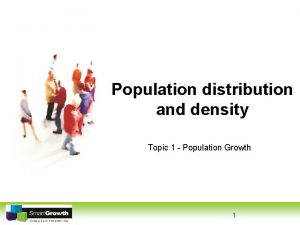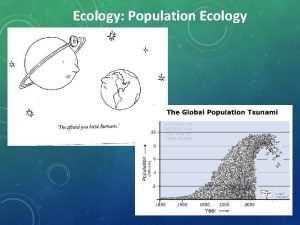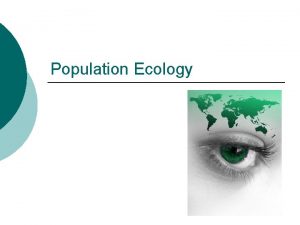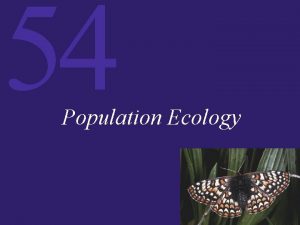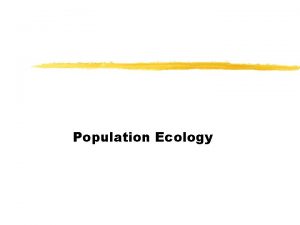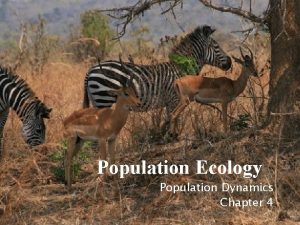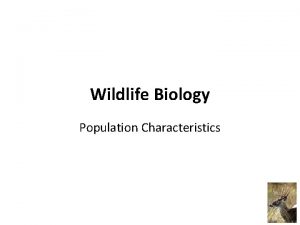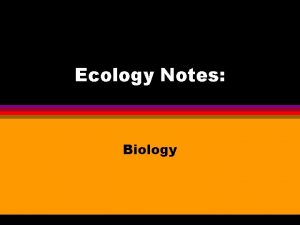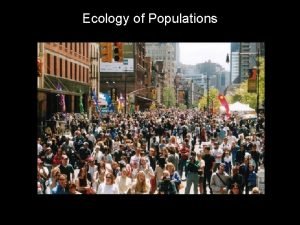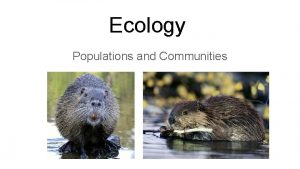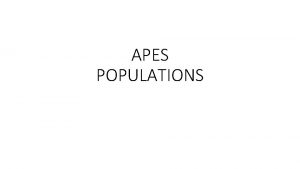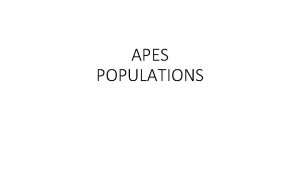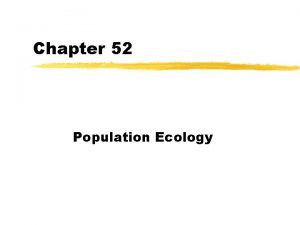Chapter 52 Notes Population Ecology Characteristics of Populations




















- Slides: 20

Chapter 52 Notes Population Ecology

Characteristics of Populations Population: a group of individuals of a single species that simultaneously occupy the same general area Two important characteristics of any population are density and the spacing of individuals Density: the number of individuals per unit area of volume

Characteristics of Populations Dispersion: the pattern of spacing among individuals within the boundaries of the population The mark-recapture method can be used to measure population density N= number in 1 st catch X total in 2 nd catch number of recaptures in 2 nd catch

Characteristics of Populations 3 Patterns of Dispersion Clumped: the individuals are aggregated into patches ex. mushrooms, animals that move in herds Uniform: evenly spaced; may result from direct interactions between individuals ex. territorial behavior, competition

Characteristics of Populations

Characteristics of Populations Random: occurs in the absence of strong attractions or repulsions Demography is the study of factors that affect the growth and decline of populations - additions occur because of birth and immigrations

Characteristics of Populations - eliminations occur because of deaths and emigration Life tables are used as a summary of the survival patterns of a population - survivorship curves plot the data for a life table - type 1 curve: low death rate during early and middle ages; drops steeply with age

Characteristics of Populations - type 3 curve: high death rate among young, then flattens out as death rate declines for adults ex. marine invertebrates - type 2 curve: mortality is constant over lifespan ex. annual plants, grey squirrel

Characteristics of Populations

Life History Life histories are diverse, but they exhibit patterns in their variability - big-bang reproduction: some plants and animals invest most of their energy into growth and development, and then expend their energy in 1 large reproductive effort; also called semelparity

Life History

Life History - repeated reproduction: organisms produce fewer offspring at a time, but do so over many seasons; also called iteroparity - limited resources mandate trade-offs between investments in reproduction and survival

Population Growth The exponential model of population growth describes an idealized population in an unlimited environment Change in pop size = births – deaths DN/Dt = B-D Scientists use r to represent the difference in per capita birth and death r = b-d

Population Growth Zero population growth (ZPG) occurs when the birth rate equals the death rate ( r = 0) Intrinsic rate ( rmax) is the fastest growth rate possible reproducing under ideal conditions

Population Growth Exponential growth is a population increase under ideal conditions d. N/dt = rmax. N - the population increases rapidly - J shaped growth curve

Population Growth The logistic model of population growth incorporates the concept of carrying capacity Carrying capacity: the maximum population size that an environment can support - symbolized as K - when N = K, the growth rate = 0

Population Growth Number of Yeast Cells Carrying capacity Time (hours)

Population-limiting factors Factors that limit growth are both densitydependent and density-independent Density dependent: death rate will rise as the population density rises - predation-prey - competition for food

Population-limiting factors

Population-limiting factors Density independent: birth and death rates do not change with density - mainly caused by weather and climate - not caused by negative feedback
 Chapter 4 population ecology test answer key
Chapter 4 population ecology test answer key Population ecology section 1 population dynamics
Population ecology section 1 population dynamics Population ecology section 1 population dynamics
Population ecology section 1 population dynamics Population ecology section 1 population dynamics
Population ecology section 1 population dynamics Characteristic of population
Characteristic of population Population characteristics
Population characteristics Chapter 53 population ecology
Chapter 53 population ecology Equilibrial life history
Equilibrial life history Ecology
Ecology Chapter 53 population ecology
Chapter 53 population ecology Chapter 4 section 1 population dynamics
Chapter 4 section 1 population dynamics Chapter 53 population ecology
Chapter 53 population ecology Clumped dispersion
Clumped dispersion Exponential growth formula ecology
Exponential growth formula ecology 52
52 Population vs community ecology
Population vs community ecology Concept 3 population ecology
Concept 3 population ecology Ecology def
Ecology def What is population ecology
What is population ecology Population definition ecology
Population definition ecology Population distribution
Population distribution




















